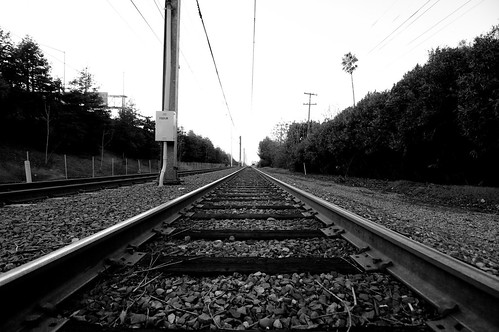Immediately I thought of my one and only lens, the Nikkor 24-85mm AF-S, a great first lens to complement my first DSLR, the very spectacular and underrated D50. The 24-85 range is a sweet-spot, offering a flexibility to zoom in on a subject at a mid-distance as well as opening up wide enough to not feel constraints in smaller spaces. With this lens, I can compose portraits and I can shoot landscapes. I never really had a problem with this lens, it is sufficiently sharp, focuses well, maybe it's a little slow in lower light.
The 24-85mm was just that though, nothing out of the ordinary, just a really great "normal" lens. I didn't want to replace my perfectly good glass, but I was jealous of my brother-in-law's lens because he could now step out of that "normal" focal range with his extended zoom ability. The focal lengths greater than 85mm allowed him to make totally different exposures, to compose from his camera at lengths.
I had curiosities about the range on the other end of my first lens, focal lengths less than 24mm. With some trade-offs, these shorter focal lengths can offer such expansive perspectives, making the photographer concentrate on composition and position. These wide angles really allow the photographer to tell a more complete story in a single shot.
I like photography because it combines science and art, and under 24mm, some of the science makes unique contributions to the art it creates. This is what draws me specifically to these wide angles. The larger viewing angles gives way to exaggerating perspectives, seeing a lot in your frame, effectively distorting and adding dynamics to the picture. Under 24mm, the photographer needs to stay on his/her feet. There is less reliance on the zoom-range from the camera; instead, the photographer needs to push close to the subject, and consciously choose what to include and exclude from the frame, being very careful with placement and the effects of the lens's distortion. At less than 24mm, for a great shot, the photographer needs to tell a story.
Jealousy for my brother-in-law's telephoto lens was the ultimate catalyst that made me also want to go beyond the limits of my rig, wider than the 24mm end of my then only lens. Eventually I landed with a great piece of glass, the Tokina 11-16mm AT-X Pro DX f/2.8. See pictures from the Tokina 11-16mm Flickr group.

Nikon D50, Tokina 11-16mm @ 11mm, f/4, 1/60s



No comments:
Post a Comment